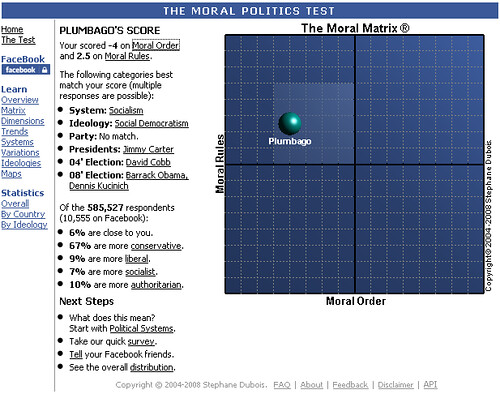With
yesterday's snow making us chicken out of a run up to London, we bummed around Southampton for the day before heading out to see
James Cameron's much-hyped
Avatar. With the exception of [shudder]
Titanic, I've always found Cameron's work a lot of fun, and his
Aliens is still one of my favourite films. But the (over)selling of
Avatar began early, so I was skeptical that Cameron would successfully tackle aliens on a remote planet
[*] for a second time.
The plot can be summarised in a single sentence: a crippled marine, Jake, goes to a distant world where his mind is projected into a fully-functional alien body, the avatar, ostensibly so that he can infiltrate the aliens and persuade them to let evil corporates rape the planet, but he goes all
fifth-column on his masters when he belatedly discovers how evil they are, and ultimately leads the aliens (read "
Native Americans") to a military victory over said
evil-doers. OK, that would probably read better as two sentences, but it's not exactly Tolstoy. Serviceable science fiction nonsense (which, obviously, I love), but not exactly
best-original-screenplay-Oscar material.
Aside from its pretty flawless integration of computer animation into live action, the other big selling point is the film's use of 3D. This is the bit I was probably more skeptical about going into the film. My first experience of this was watching, or rather
trying to watch,
Creature from the Black Lagoon in crappy
anaglyph-o-vision[**] way back in youth club when I must have been 10 years old. I then managed to dodge 3D for more than two decades, and figured it was dead, until I caught one about the
ISS on IMAX in Florida. That was kind-of OK, but IMAX is still a sufficiently novel experience for me that it was difficult to separate the 3D from that. All of which makes
Avatar my first experience of mainstream cinema 3D.
Coming out of the film, I'm still not convinced that 3D is the way forwards. Leaving aside the massively inflated ticket price (it cost us slightly less than double a seat at our local arthouse cinema), 3D just doesn't bring enough to the table to my mind. Firstly, it obviously does absolutely nothing for normal cinematic conventions like plot or character. A film will still stand or fall based on it making coherent internal sense and being filled with engaging characters,
not on whether some of said characters appear slightly closer to the viewer than others.
Secondly, for all of
Avatar's technical prowess, there were still moments where its 3D became briefly incoherent and times when I had to consciously make it 3D by re-focusing my eyes. For instance, early in the film there's a fast chase through a beautiful jungle that has the viewer racing along with Jake's avatar. Unfortunately, there's so much 3D information passing so quickly that my eyes gave up the ghost and the whole sequence was lost on me as a 3D spectacle. Other times, particularly in enclosed scenes, I found myself looking around the frame to objects much closer than the subjects that Cameron wanted me looking at, objects that were either difficult to bring into focus in the first place or which made it difficult to change focus when the action moved on.
Anyway, overall the 3D is pretty impressive, but I remain unconvinced that it's the way forwards for cinema. I think it's not a bad trick for spectacles like
Avatar, but I'm not sure it'll add anything to conventional, character-based films. And there's still the economic aspect to whether studios will support it, namely: since DVD is now a major way by which films recoup their costs and make profits, and since TV is a long way from 3D and is inherently an unlikely platform (would you like to watch little 3D figures battle it out in a corner of your living room?), studios can't make a buck from the extra costs 3D films take to make. So I still remain to be persuaded on 3D.
Changing tack, is conventional, 2D
Avatar up to much? Generally yes, but I don't think that it's up to Cameron's usual standards. I was kind-of suckered by the biological detail of the world, Pandora, that he's created, but I suspect that most people don't appreciate, or even spot, the
homologies in the Pandoran fauna. I also suspect that many of Cameron's usual fans might be a little put-out by his flagrant tree-hugging as well. Again, this is something that I don't mind ... too much, but I would imagine that many more gung-ho fans might find themselves sympathising with the evil corporation's more
laissez-faire attitude to Pandora's natural wealth. Furthermore, the underlying theme of biological unity sits
interestingly with the heavily weaponised spaceships and exoskeletons.
There were one of two items I did particularly like or engage with. Firstly, that Cameron carries the idea of avatars further than simply the body that Jake "occupies". Both the corporate mercenaries (and their exoskeletons) and the native Na'vi warriors (and their mounts) extend themselves into the platforms they ride on, so there's a kind-of meta-avatar thing going on. I also quite liked the (ultimately new-agey) biological oneness that ties Pandora together. I was hoping that it might have a more sciencey explanation by the end (as hinted by
Sigourney Weaver's scientist character), but Cameron left it as some mystical mumbo-jumbo that one had to gloss over. And, of course, I'm always suckered by films that use the evil-corporation-vs.-oppressed-underdogs dynamic. Although they were giant, blue-skinned and digitally-rendered space aliens, I totally got behind them.
I did wonder how Cameron will follow this one up though. We'll see.
[*] Actually, it's a moon of a gas giant that looks suspiciously like Jupiter. Admittedly, aside from zonal banding, the gas giants we're familiar with can look a little boring, but did Cameron really have to cut-and-paste Jupiter's
Great Red Spot onto his fictional companion of
Alpha Centauri? I'd have thought he could have been a bit more imaginative than that - perhaps two giant spots that merge during the film in some sort of meta-thing? He totally should have come to speak to me.
[**] Much to my surprise, I've just this minute discovered that the film was originally shot with the kind of polarised light 3D that is more popular nowadays, and which
Avatar uses. I always figured that red-and-green were the official colours of the flag of ancient 3D films.
 The collection is Egan's first, and consists of stories published between 1989 and 1992. Pre-blog, I read his later collection, Luminous (which was also a present from C), and it definitely confirmed him as a must-read for me. The stories here range extremely widely in their subject and intent, although plasticity of mind, body and reality is a recurring theme.
The collection is Egan's first, and consists of stories published between 1989 and 1992. Pre-blog, I read his later collection, Luminous (which was also a present from C), and it definitely confirmed him as a must-read for me. The stories here range extremely widely in their subject and intent, although plasticity of mind, body and reality is a recurring theme. 




.png)
















